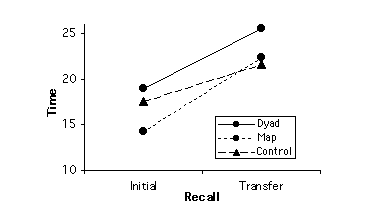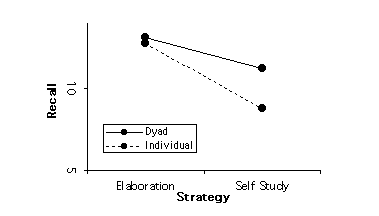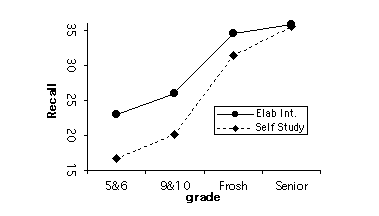Learning Strategies
It was not that long ago (at least by my standards), that researchers began using the term "learning strategies", and, as I mentioned in a previous Virtual Lecture, I was fortunate enough to work with Don Dansereau, of Texas Christian University who was one of the first to conduct research within this area. The area became popular because researchers had begun to identify certain characteristics in the way that effective learners went about studying, that seemed independent of knowledge about a given subject. More importantly, the research became particularly interesting and useful when evidence started to accumulate that these strategies could actually be encouraged and taught. One example, supported by a host of studies, is Dansereau's four step cooperative learning script mentioned in an earlier virtual lecture and your text. Much research in effective learning strategies boils down to the topic of the first virtual lecture, "active learning". Effective learning strategies are those that involve active manipulation of the material, especially when the learner in some ways "makes the material his or her own". There is much wisdom to the old adage about putting information in your own words. This is almost surely one of the principal reasons that collaborative learning can be so effective when practiced correctly. The student is required to explain information to a peer, and is thus required to manipulate the information and integrate it into existing cognitive structures, before it is verbalized to the study partner or partners. To do all this, it does not require that other students are present, it's just that most students instinctively do this when communicating with peers. Effective students will often rewrite material in their own words or, in some cases, even "teach" the information to imaginary others, such as a student I had a few years ago in Educational Psychology, who explained his method of studying on a Web disucssion board:
I call all of my imaginary friends and have them come over. I teach my imaginary friends all the cool stuff I just learned.
To illustrate my point about the importance of active manipulation I will describe two experiments. First of all in 1996 I conducted an experiment with U.M.R. general psychology students (Hall, Sidio-Hall, & Saling, 1996). Students in this experiment studied information from their general psychology text that they had not yet covered in the class. First, students studied information on sound waves for half of a class period using one of three methods. One third of the students studied the information in dyads using Dansereau's four-step strategy. One third studied from "knowledge maps" which are node-link spatial text displays sort of like flow charts that show the relationship between groups of text within nodes in a nonlinear fashion. One third of the students studied individually using whatever method they thought would be most effective. For the second half of the class period all students studied a passage on the structure of the eye using whatever method they thought was most effective. The reason for this second portion of the session was to study "transfer". The question with respect to transfer was: did the experience of using the given learning strategy in the first half of the class period affect later studying when students were not required to use a specific strategy. Students completed a free recall test over both sets of materials two days later.
We spent considerable time and effort creating the "knowledge map", and tried very hard to make the spatial lay out of the map represent the information to be learned. However, despite all this effort, the fact is the map did not require the students to actively manipulate the information in the same way that the simple four step cooperative learning strategy did and the results reflected this (see Figure 1). Those in the cooperative learning group scored higher on both initial learning and transfer. On the other hand, those in the map scored lower than even the control group in initial learning and only slightly higher on transfer.

Figure 1. Recall as a Function of Group and Time (Hall et al., 1996)
In a fairly recent issue of the Journal of Educational Psychology, Eileen Wood and colleagues examined the effectiveness of cooperative learning and specific strategy instructions with 486 students at different grade levels (5-6, 9-10, College Freshman, & Seniors) (Wood et al., 1999). All students at each grade level learned facts about animals that were listed in sentences and were tested on retention for the facts afterwards. Researchers also audiotaped the sessions to assess the processes that went on during studying. Half of the students studied the information with a partner and half individually (the individuals were required to "think aloud" as they studied, for the sake of the audio tapes). Within these two groups, half of the students were given "explicit" strategy instruction and half were not. The "explicit" strategy instruction entailed requiring students to answer "why" questions about each of the sentences they studied. In terms of our discussion above, these "why" questions would require that the students work actively with the information to be learned, and to relate it to information they already knew. This experiment, then, consisted of four conditions as illustrated in Figure 2.
| Dyad | Individual | |
| Explicit Instruction | Explicit-Dyad | Explicit-Individual |
| Non-Explicit Instruction | Non-Explicit Dyad | Non-Explicit Individual |
Figure 2. Four experimental conditions in Wood et al. (1999) Experiment
The researchers found that, over all, students who studied in dyads performed better on recall tests than those who studied individually, and that those who received explicit strategy instructions performed better on recall tests than those who did not (figure 3 are the means from the 9-10th graders). Their audiotapes also revealed that those who studied in dyads exhibited more of the characteristics of effective study strategies (e.g., using mnemonic techniques, and using visual imagery). This consistent finding, that activities that encourage active manipulation of information to be learned lead to better learning across multiple age levels with a large number of subjects adds even stronger support for the importance of these activities, and also adds support to the contention that these types of activities can be taught and encouraged.

Figure 3. Recall as a Function of Strategy and Study Format for 10th graders (Wood, et al., 1999)
One other interesting detail is that it appears that students who are successful enough to get to college, and even more so to get to their senior year, have, to some extent, integrated these strategies into their own studying. This is indicated by the additional finding in the Wood et al., experiment that "explicit" strategy instructions were more effective for younger students than for older, in that there was a larger difference between "explicit" and "non-explicit" group on performance with younger grades, than with older (see figure 4).

Figure 4. Recall as a Function of Grade and Strategy (Wood et al., 1999)
References
- Hall, R.H., Sidio-Hall, M.A., & Saling, C.B. (1996, April). A comparison of learning strategies within the context of a post-secondary class: Effects on initial learning and transfer. Presentation at the annual meeting of the American Educational Research Association, New York, NY.>
- Wood, E., Willoughby, T., McDermott, C., Motz, M., Kaspar, V., & Ducharme, M.J. (1999). Developmental differences in study behavior. Journal of Educational Psychology, 91(3), 527-536.